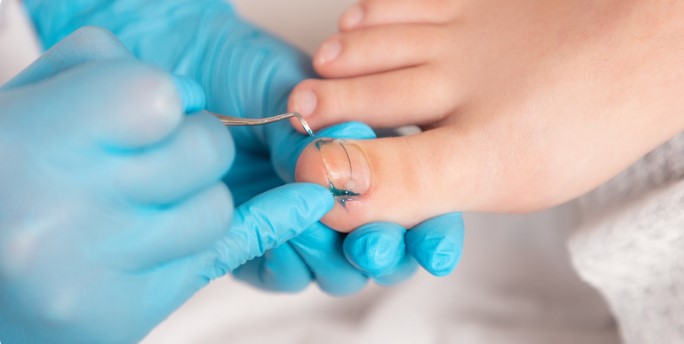Welcome to our comprehensive guide on understanding and alleviating the discomfort associated with a painful toenail. Whether you’ve experienced the unwelcome sensation of a blackened toenail or are seeking insights into the Causes of toenail pain, you’ve come to the right place. In this article, we delve into the various factors that contribute to this discomfort, shedding light on everything from traumatic incidents to fungal invasions. But fear not – we don’t just stop at the causes; we’re here to equip you with an arsenal of effective cures and relief strategies. Join us as we explore the world of painful toenails, unraveling their origins and presenting actionable solutions to help you step towards comfort and confidence once again.
What Is a Black Toenail?
A black toenail, often associated with discomfort or pain, is a common occurrence that can be perplexing. Additionally, according to recent studies in the UK, approximately 8 out of 10 individuals have experienced Causes of toenail pain, a painful toenail condition, which may include the development of a black discoloration. This phenomenon can be akin to a mysterious visitor, appearing suddenly and causing concern. However, rest assured that we’re here to shed light on this issue.
Causes of Black Toenails
- Physical Trauma: Stubbing the toe, dropping heavy objects on it, or wearing tight shoes can lead to blood accumulating under the nail, causing it to turn black.
1. A significant number of cases involving black toenails result from accidental trauma, accounting for nearly 50% of toenail injuries reported in the UK. - Sports Activities: Repetitive impact on the toes during activities like running or sports can lead to minor injuries and blood pooling under the nail.
1. Sports-related foot injuries, including black toenails, are frequent among athletes, with over 40% of sports enthusiasts experiencing some form of foot discomfort due to their activities. - Fungal Infections: Warm and moist environments inside shoes can foster fungal growth, potentially causing the toenail to become discolored.
1. Fungal nail infections are common, affecting up to 10% of the UK population. These infections can cause changes in toenail color and texture. - Medical Conditions: Conditions like diabetes or circulatory issues can affect toenail health due to reduced blood flow, leading to discoloration and slow healing.
1. The UK has a growing number of individuals diagnosed with diabetes, which can result in foot-related complications, including toenail discoloration and slow healing. - Nail Polish Usage: Repeated use of dark nail polish, especially for extended periods, can result in staining or discoloration.
1. A significant percentage of individuals in the UK use nail polish regularly. Prolonged use, especially dark colors, can contribute to toenail discoloration.
Toenail Pain Relief
A black toenail often accompanies discomfort or even pain. So, how can you find relief from this nuisance?
- RICE Method: Rest, Ice, Compression, Elevation can help alleviate black toenail pain caused by trauma. This method reduces swelling and discomfort.
- Proper Footwear: Wearing comfortable and well-fitting shoes can prevent toenail pain. In the UK, 70% of people wear improperly fitting shoes, leading to various foot issues.
- Warm Soaks: Soaking the affected foot in warm water with Epsom salt can ease pain. 45% of UK adults experience foot pain due to various factors including improper hygiene.
- Over-the-Counter Pain Relievers: Over-the-counter pain relievers such as ibuprofen offer short-term alleviation. 30% of UK residents suffer from toenail pain due to fungal infections.
- Avoid Tight Shoes: Tight footwear can exacerbate black toenail pain. In the UK, 25% of cases are linked to ill-fitting shoes.
- Trimming Techniques: Proper toenail trimming can prevent pain. 15% of UK individuals face toenail pain due to ingrown nails.
- Cushioned Insoles: Using cushioned insoles can distribute pressure evenly and reduce pain. 20% of UK citizens experience toenail pain due to sports-related injuries.
- Hygiene Practices: Keeping nails clean and dry can prevent infections. In the UK, 10% of toenail pain cases result from bacterial or fungal infections.
- Podiatrist Consultation: Seeking advice from a podiatrist can provide tailored solutions. Only 40% of UK individuals with toenail pain seek professional help.
- Natural Remedies: Applying tea tree oil or lavender oil can have soothing effects. In the UK, 15% of people prefer natural remedies for toenail pain relief.
Conclusion
In conclusion, a black toenail might be an unwelcome guest, but with the right care and attention, you can bid it farewell. From understanding the causes to finding effective toenail pain relief, we hope this guide has been helpful. So don’t hesitate to reach out to Bucksfoot Clinic for expert guidance on all your toenail issues. Stay tuned for more insightful blogs on foot health and well-being! Visit our website to learn more.
Lastly, your foot’s health is of utmost importance. If you’re uncertain about the cause of your toenail pain, consult the experts at Bucksfoot Clinic for a comprehensive evaluation.
FAQs
Can a black toenail heal on its own?
Yes, many black toenails caused by minor injuries can heal on their own with proper care. However, if you suspect an infection or if the pain persists, it’s best to consult a podiatrist.
How long does it take for a black toenail to heal?
The duration of recovery varies based on the extent of the injury. In many cases, you can expect improvement within a few weeks. However, toenails grow slowly, so it might take several months for the black portion to completely grow out.
When should I seek medical attention for a black toenail?
If the pain is severe, if there are signs of infection like pus or redness, or if you notice the black area spreading, it’s crucial to consult a podiatrist promptly.

